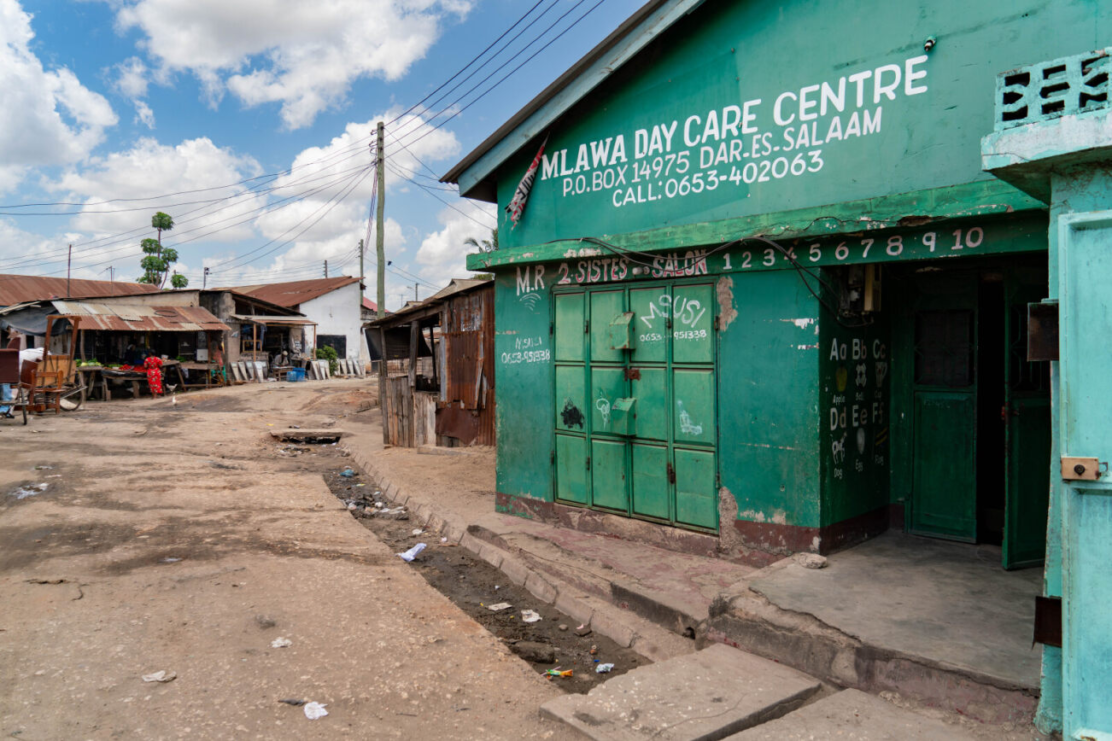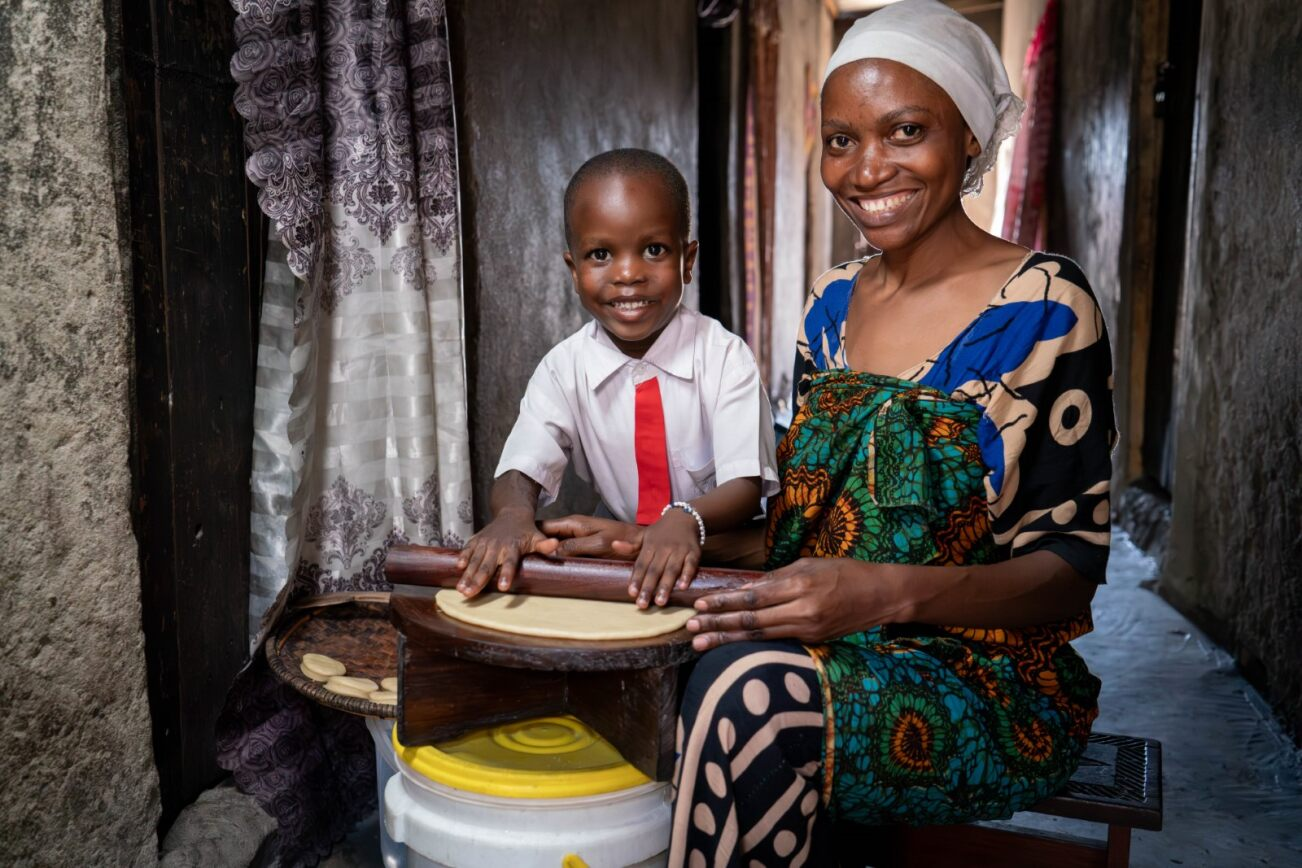Early Childhood Development is Intricately Linked to Women's Participation in Employment, Wellbeing and Social Capital
In Children in Crossfire’s early childhood development work in urban Dar es Salaam, increasingly it is becoming clear that working with children is necessary but not sufficient. We find that we must take a 2-Generation or whole family approach as it is a context in which women’s participation in employment, their wellbeing and social capital are intricately linked with the availability of high quality, safe, accessible child-care. Most of the childcare workforce as well as the customers of the child-care centres, in the context of high-density low-income Dar-es-Salaam, are young women between the ages of 18 and 40, and earning less than $4/day.
Daycare centres in Dar-es-Salaam
Dar-es-Salaam City (Dar) in Tanzania is one of Africa’s fastest growing cities, with a population estimated at 5.5 million. There are more than one million children under the age of 5, constituting the second largest demographic in Dar (2022 Census); yet only half of Dar’s 2-5 year olds (51%) are reported as developmentally on track (TDHS 2022).
Government interventions in Tanzania are targeted to the first 1,000 days of life (0 to 2 years) and are prioritised through the health sector, however, there remains a policy gap for 2- to 5-year-olds. In the fast-growing context of Dar this creates a perfect storm. Young families are streaming into the city in search of better economic prospects and are dependent on subsistence livelihoods. They leave behind familiar family and community childcare networks. Both parents must earn a living to survive, and safe and reliable childcare is a vital need. This soaring demand is fulfilled by a mushrooming economy of private daycare centres constituting 90% of childcare provision in Dar.
Children in Crossfire (CiC) is an international NGO based in Northern Ireland, with a focus on early childhood care and education. They are working with daycare centre owners to build proof of concept of what high quality early childhood development (ECD) can look like in this unique resource constrained context. In parallel they are partnering with government to build fit-for-context quality assurance tools and processes. The goal is to improve the quality of provision to maximise the lifelong outcomes for children attending these day care centres.
CiC commissioned a baseline study to better understand the demand and supply of early childhood services in high-density Dar. Employing a mixed methods design, the sample included 100 daycare centres, 200 care workers, 220 children, and 220 parents, as well as local government.
The study found that Dar daycares are small enterprises run by local micro-entrepreneurs with little security of tenure of the premises. They are typically unregistered as they fail to meet the government’s stringent quality standards for infrastructure. They charge low fees (USD 6 to 10 per month) and survive in a low-margin low-growth sector, unable to make investments in quality improvements which would allow government registration and subsequent support.
On average, across the sample, each daycare enrols just over 80 children. Slightly more than half of the daycare reported that they enrol the most vulnerable children, the majority being from extremely poor households (61%). These daycares have informal support mechanisms in place such as fees concessions and free feeding.

A typical daycare in high density Dar es Salaam.
Children enrolled in daycares had better development outcomes compared to peers who were not enrolled. Just over half (53%) of children enrolled in daycare achieved age-appropriate milestone development scores compared to only one-third (32%) of children not enrolled in daycare. Despite weak quality assurance systems and structures, the sector appears to be benefitting children whose families can afford the fees. There remain difficult challenges related to equity for those parents who are stuck in a vicious cycle of low income and lack of childcare.
Childcare in Dar is perceived to be a women’s issue
The baseline revealed the extent to which the question of ECD is intricately linked with the questions of women’s livelihoods, empowerment, and wellbeing. It found nine out of ten primary caregivers were female (mostly mothers), 70% of whom are married. About half (54%) of the mothers reported completing primary school. Only two out of ten caregivers reported daily engagement of fathers in childcare. Three-quarters (78%) of the households reported an average daily income of less than TSH 10,000 (US$4), with 70% of caregivers engaged in small businesses or entrepreneurship, and 10% reporting no income source at all. Moreover, half of those with an income report it as unstable.
Nine out of ten caregivers have enrolled their children in daycare, and the main reasons cited were for their children to have opportunities to play and learn, prepare for school, and perceived children’s safety at daycare compared to the home and community while parents were away at work. Parents almost universally reported being satisfied with their daycare, an important insight within the prevailing high-density context and assessed lower quality of daycare.
Additionally, the study found that the workforce in the sector is predominantly female (86%), and between the age groups of 18-34 Years (78%). Eight out of ten care-workers have completed at least secondary school, and a third have completed tertiary qualifications. However, only half of the care-workers reported any pre-service or ECD-related qualifications. This is compounded by more than one-third reporting not to have received any in-service training support related to their ECD role.
Both the demand and supply sides of the sector are made up of young women, with high potential for economic participation, growth and development. The childcare sector in Dar is perceived to be a women’s issue, being solved by women, in the absence of any formal support from government or any other systemic mechanisms. It is yet to be fully recognised as a universal, social and economic issue with implications for human capital as well as women’s labour participation.
The intersection of gender and urban poverty
In 2018 the Population Division of the United Nations Department of Economic and Social Affairs (UN DESA) launched the 2018 Revision of World Urbanization Prospects. It projected that by 2050, 68% of the world’s population would be living in urban areas. As this rapid pace of urbanization unfolds, it places a burden on limited resources. Sustainable development in low- and middle-income countries is increasingly dependent on the successful management of urban growth. In Dar, 70% of the population lives in informal high-density settlements (DFID 2015) compounding risks related to climate change and economic uncertainties. To make cities inclusive, safe, resilient, and sustainable (SDG 11) a greater emphasis to meet the unique needs of the urban poor is needed.
Families living in urban poverty face housing insecurity both in terms of stability of structure and security of tenure. They live in cramped spaces with poor access to water, sanitation, health and nutrition. Most often these families live in highly polluted environments, with limited access to green spaces, unstable electricity supply and other health and safety hazards. Finally, they have limited access to educational and economic opportunities in their communities. These factors compound to create a situation of ‘household deprivation’. The parallels between urban poverty and protracted emergencies seem obvious. The economic, social and psychological impact on families is similar, and in both cases, the burden falls disproportionately on women and children.
A recent feature in the Economist argues that availability of high quality, affordable and universal childcare will alleviate some of this deprivation as it allows “families, especially women, to allocate more time to work and leisure, earn more money, support children’s learning and development, and could generate between $2 to $4.5 trillion of additional GDP each year.”
Implications for policy and practice
Increasingly, it is becoming clear that the childcare sector must work through partnerships across state and non-state actors and across multiple sectors. While a focus on children and children’s early developmental outcomes is necessary, it is not sufficient in the complex situation of urban poverty and household deprivation. A concerted and coordinated effort is needed to offer joined up services in the interest of family needs. In Children in Crossfire’s study, almost all daycares provided extended hours to mirror parents’ work, and this was one of the most popular selling points for parents.
In the highly gendered sector of childcare, working towards equity and empowerment of women will mean addressing the gender imbalance in childcare roles and responsibilities. Recently the question of fathers’ participation in childcare, and its’ positive effect on children’s early development outcomes, has become an important theme in low- and middle-income countries. Research shows that not only the direct interaction of fathers with young children, but equally, and even more importantly, the indirect support that fathers provide to children by being supportive towards and actively partnering with mothers, leads to better maternal mental health and wellbeing and ultimately creates better outcomes for young children.
Early childhood development is by its very nature, multisectoral, combining services across health, nutrition, early learning, care and protection, and, safety and security. The Nurturing Care Framework recognises that a young child’s life is dependent on the parents’ ability to provide responsive care and inherently places the child within the sphere of family wellbeing. This necessitates extending care not just to the child, but rather a chain of care reaching, children, mothers, and fathers. Such an approach will have to be more intentional about addressing the needs of the young women who make up both primary caregivers in the home, as well as care-workers in the daycares. It will require effort and investment in augmenting the earning potential of women and their participation in the workforce. Freeing families from the burden of childcare will unlock the opportunity cost disproportionately borne by women.
About the Author:
KanuPriya Jhunjhunwala is Head of MEL & Education at Children in Crossfire.

